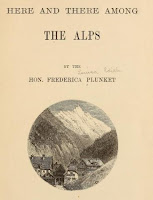Frederica Louisa Edith Plunket was born at Kilsaran, near Castlebellingham in County Louth (1838-1886). Her father Thomas Plunket, 2nd Baron Plunket (1792–1866), was a junior Church of Ireland clergyman and later became the Bishop of Tuam, Killala and Achonry where he gained some notoriety for his behaviour during the Great Famine era.
Her mother Louise Jane Foster (married in 1819) was the daughter of John William Foster of Fanevalley, County Louth, Member of Parliament for Dunleer. Her eldest sister Katherine Plunket was known as Ireland's oldest person at 111 years and 327 days.
Plunket travelled Europe with her sister Katherine Plunket and they made many sketches of flowers in France, Italy, Spain and Germany, and Ireland. These were bound in a volume, Wild Flowers from Nature, which was presented in 1903 to the Royal College of Science, and was later transferred to the Museum of Science and Art in the National Museum of Ireland. In 1970 it was part of the collections which were transferred to the Irish National Botanic Gardens at Glasnevin. (Wikipedia)
At present there is little information available about her early life and career and it is not clear what inspired her to undertake mountaineering but in 1875, with her sister, she climbed the Eiger and Mt Blanc. The following year they climbed Monte Rosa and the Strahlhorn (with guide Peter Egger).
'Here and there among the Alps' (1875) is her account of some of her climbing activities and is written to encourage other women to undertake the activity. The following is a short excerpt from the introduction:
In offering the following pages to the public, the authoress is actuated, not so much by the motive to describe her own especial excursions, as by the wish to persuade other ladies to depart more than is their usual habit from the ordinary routine of a Swiss summer tour ; to urge them no longer to pause on the threshold of the Alpine world, but to pass its snow-marked boundaries, and to see and admire for themselves those wonders of nature which many of them are content to gaze on from a distance, thus losing half their beauty.
Go to Home for full site map



No comments:
Post a Comment